More and more riders appreciate the benefits of full-face helmets, not just for the comprehensive crash protection they provide, but also for the additional wind and weather protection afforded by the fully encircling shell and face shield. But wearing a regular full-face lid has its disadvantages. If you wish to converse easily with your buddies at brief stops or have a soda or something to eat, you have to remove a full-face helmet. For glasses wearers, that means taking them off first. And there isn’t always a safe place to put the helmet, leading to drops, scratches and even theft. Leaving it on at a rest stop can get warm, too.
Years ago, the only alternatives to full-face helmets were the ½ or ¾ open-face lids, which are lighter, less expensive and more sociable when you stop. They only provide partial crash protection, however, like riding with your jacket unzipped or wearing just one boot or glove.
Today it is possible to have nearly the best of both worlds by wearing a “flip-up” or modular helmet. These offer most of the frontal impact and weather protection of a full-face helmet, with much of the convenience of an open-face when you pivot open the chinbar.
Because the chinbar flips up and out of the way along with the face shield, modular helmets are popular with tour guides who want comprehensive protection but often need to give their clients quick and clear directions. Glasses wearers like them since you can flip the front of the helmet out of the way for talking, eating, etc., without having to remove your specs. And though you should never ride wearing a modular in the flipped-open position, they’re cool enough flipped open that you can often leave them on at stops.
Recent improvements to modular helmets include integrated Bluetooth communication systems (usually optional), and sun shields that drop down from inside the top of the helmet. The latter eliminate the need to carry a separate dark shield, and every helmet in our test here is so equipped. By utilizing a sliding control, the darkened shield (similar to those used by military fighter pilots) pivots down into place from above the eyeport and acts as a sunglass. It protects the rider’s vision, is easily deployable in the sun, and likewise easily retractable for tunnels or when day turns to dusk.
While most modular helmets still strap to the rider’s head with the traditional double D-rings, many of the helmets included here make use of a quick-release ratcheting buckle arrangement. It is extremely easy to latch and adjust by inserting the rigid, serrated strap into the buckle; it unlatches by simply pulling a tab that opens the buckle and allows the strap to slide right out. The only drawback is that a helmet so equipped cannot be directly secured to a traditional motorcycle helmet lock unless it offers a separate ring for that purpose.
To increase comfort on a hot day, each of these helmets has controllable vents. One brings in air from the chinbar that also helps deal with fogging of the face shield, and vents in the crown deliver cooling air across the top of the head. Each helmet here has a removable, washable liner, and most utilize a variation of the popular rear spoiler shape. Each is available in a variety of colors; check the website for specifics.
To be legally sold in the U.S., any motorcycle helmet must pass certain impact and other tests, and carry a sticker that says it meets the standards of the Department of Transportation (DOT). The manufacturer certifies that each of these helmets passes DOT, and several also pass the stricter standard of the European Union (ECE 22.05), which usually includes the flip-up chinbar. None of the helmets here carry the voluntary certification of the Snell Memorial Foundation, which states that, “It has not had the opportunity to test any of the flip up front type helmets for certification” (though Zeus in the UK says that its flip-up is Snell certified). Snell goes on to state that, “We do not find any fault with these designs as long as they are used according to the manufacturers instructions and meet all of the requirements of the standard.”
A modular helmet does have a few drawbacks. In terms of safety, a standard full-face helmet is pretty much going to remain intact should you go sliding down the road. With a modular, however, there is the remote possibility that, should it be impacted in a certain way, it could conceivably open, exposing the rider’s face to injury. To lessen this possibility, be certain that any modular helmet you consider buying has (like all of those tested here) a metal-to-metal latching system for the chinbar, and that it is securely locked while riding.
Because of the additional hardware related to the mechanism, modulars tend to be more bulky and several ounces heavier than a full-face, and somewhat more expensive. Our lightest modular here weighs 3 pounds, 9.5 ounces, and the heaviest is more than 4 pounds. In our last full-face helmet buyers guide, the average weight of the helmets was about 3 pounds, 8 ounces.
Modular Helmets Buyers Guide
AGV Numo EVO Stinger
$299.95 / 4 lbs., 5.7 oz. / DOT only
The first impression is that the Numo is a large, heavy hat, and our scale reveals that it is the heaviest in our test. AGV states that the shell is made of High-Resistant Thermoplastic Resin, and I found that opening its chinbar requires a smart tug with the thumb on the latch underneath, which is an awkward motion and requires more force than most. The sun shield deploys easily, but does not extend down as far as most, leaving a distracting bright area along its bottom edge.
The chinbar vent brings in a good amount of air, but has only an open and closed position; it really needs an intermediate position for partial airflow. The controls on its twin crown vents are small and difficult to find, especially while wearing gloves. They do offer two open positions, yet do not provide near as much airflow as the chinbar vent.
I ordered all helmets in size medium, and of these the Numo had the loosest fit. The interior liner is comfy on the skin, and its ratcheting buckle retention system works well. Its shield attaching mechanism is among the easiest to use. Overall, however, the Numo could use some refinement in terms of venting, chinbar latching and weight control.
Bell Revolver EVO
$199.95 / 4 lbs., 0 oz. / DOT only
A revised edition of an earlier helmet, this new EVO has a polycarbonate alloy shell with a redesigned eyeport seal. It took some care to work my eyeglass frames inside, and the helmet generated a fair amount of wind noise while riding. The chinbar vent moves a good amount of air, but the crown vents pass only a minimal amount.
Bell’s shield removal system is the best! Raise the shield, push a lever on each side and the shield pops off. To reinstall it, simply rotate the shield back in place, release the lever and it’s home.
Every helmet, even within its size range, fits slightly differently. Within our helmet group here, the Bell was the narrowest and put pressure on my cheeks. This is simply to make the point that because fit is so important, I strongly suggest that you purchase your helmets in person at a bike shop.
The Revolver’s style is top notch, it’s priced right, but it’s at the heavy end of the scale and fit is a concern. Its chinbar operates well, its sun shield provides good coverage and shield changing is easy. Top venting could be better and I recommend earplugs when riding.
BiLT Techno Bluetooth Modular
$399.99 (promotional price $199.99) / 3 lbs., 12.8 oz. / DOT only
Bilt refers to the Techno Bluetooth Modular as its most technologically advanced helmet, as it is supplied with electronics that can sync with Bluetooth-enabled devices to provide mobile phone communications, GPS navigation instructions and MP3 connectivity. It can also be paired with another Bilt Techno helmet to provide rider-to-rider or rider-to-passenger intercom communications with its built-in microphone and speakers. It’s constructed of an injection-molded polycarbonate shell, the interior is comfy and its sun shield provides excellent coverage. Because testing the electronics is beyond the scope of this article, I did not sample their abilities.
Underway, the helmet was quite noisy, a factor I traced to the communications pod/volume control protruding from its left side. The chinbar vent is largely ineffective, as are the sliding top vents; I could feel hardly any air movement internally when these vents were opened. It’s also the only helmet here that does not offer toolless shield removal. You’ll need a screwdriver to remove the sideplates first, and when they come off, several little pieces can potentially fall and be lost.
Though its shape appears high-tech and its electronics are an attraction, overall the Bilt helmet was disappointing in terms of noise control and ventilation effectiveness.
Fulmer M2B
$179.95 / 3 lbs., 14.6 oz. / DOT and ECE 22.05
With a shell constructed of ABS and carrying that popular rear spoiler shape, our M2B looks very high-tech in its “The Darkness” graphic. Its interior is somewhat firmer than most others, so it has more of a supportive rather than cushiony feel. Its sun shield deploys easily, but leaves a finger-width opening at the bottom where light comes through.
While its chinbar vent is not very effective, its two-position twin crown vents deliver a good, controllable amount of cooling air. The shield removal process is one of the easiest here. With the shield lifted, slide a mechanism rearward on each sideplate and the shield pops off. To restore, pop the shield’s tabs back into the mechanism and slide it forward to engage.
What impressed me is that the Fulmer M2B is the least expensive helmet in our test, yet there’s nothing cheap about it. The sun shield deploys well, though it could cover a little more area. While the chinbar venting is minimal, the crown venting works quite well. The graphics on our test helmet are first-rate, and of course it has that rear spoiler shape that nearly everyone utilizes today. Overall, it provides a lot of value for the money, and you’ll have to spend much more to find superior function.
HJC RPHA Max
$459.99 (solids), $464.99 (metallics, pearl and matte), $499.99 (graphics) / 3 lbs., 9.5 oz. / DOT only
HJC has been producing price-point helmets for years, and RPHA (which stands for Revolutionary Performance Helmet Advantage) is the company’s new premium line. The Max, its top modular, is made of a blend of carbon fiber, Aramid fiber, fiberglass and fabric. While riding, I immediately noticed that the RPHA Max is one of the quietest helmets in our test, and at 3 pounds, 9.5 ounces, it’s also the lightest. Its sun shield deploys with a sliding control along the top of the helmet, retracts with the touch of a button, and its chinbar latch is extremely easy to operate.
The chinbar vent sends a flow of air up inside the shield, and its single top vent sends in a rush of air at speed that tousles the hair and offers significant cooling. I would prefer, however, an intermediate vent setting. Also, the exhaust vents on top do not close, raising the possibility of water entering on a rainy day. Finally, raise the shield, push a lever on each side and the shield pops off for cleaning. It’s just as easy to reinstall.
With lightness, comfort, decent ventilation, ease of operation and the Pinlock anti-fog insert included, the RPHA Max is one of the picks of this litter.
LS2 FF386
$219.95 / 3 lbs., 12.4 oz. / DOT and ECE 22.05
The shell of the FF386 is made of HTPP composite material, and the chinbar opens easily with a single button. A lever on the left side deploys the sun shield, which is large enough to fill virtually the entire open field of vision. The FF386 is moderately quiet, and its two-stage chinbar vent is controllable and moves a good volume of air at highway speeds. Its top vent is unique in that a flat plate atop the helmet covers it. The rider pushes down on this plate to open it, and closes it by pushing a small latch at the rear. Because the plate lies nearly flat, though, it does not bring in a great amount of airflow, and what comes in is concentrated in a rather small area.
The chinstrap is secured with a ratcheting buckle, which is very easy to open by pulling a short strap. Removing the shield is a tricky operation that requires opening it, then sliding a couple controls. At that point the retainers on the sides pop off, and could possibly become lost. Replacing the shield requires a similar operation.
With a bit more effective venting at the top and simpler shield changing, the FF386 would be a darn attractive value.
Nolan N104
$449.95 / 3 lbs., 12.5 oz. / DOT and ECE 22.05
Nolan’s N104 features a Lexan polycarbonate shell with a spoiler shape for improved stability, and a Pinlock insert is included. The adjustable quick-release ratcheting buckle system is slick and extremely easy to use. The sun shield is easily lowered by a slider, and retracted by a spring when the release button is pushed. Face shield release and reattachment is clever and easy.
The chinbar release is unusually easy to operate, consisting of a tab on the underside that deploys another tab above it; squeeze them together for ease in opening. The chinbar utilizes a patented elliptical mechanism so that it swings out farther from the rider’s face, then tucks in closer to the helmet to reduce wind resistance when riding with the helmet open…which you’re not supposed to do.
Slide the top vent control back one click to expose the crown vent, then another click to open the forehead vents. Even when utilized together with the chinbar vent, however, the system does not move a lot of air. If you crave communications, the helmet will accommodate Nolan’s optional N-Com B4 communication system, which is quite advanced. Overall it’s comfortable, quiet and clever, but could use more effective venting.
Schuberth C3 Pro
$769 (solid colors), $799 (hi-viz), $829 (graphics) /
3 lbs., 10.3 oz. / DOT and ECE 22.05
A premium version relative to the existing C3, the new C3 Pro offers numerous updates including a shaped rear spoiler for additional downforce and stability, acoustic changes that Schuberth says reduce noise by two decibels, a new top vent scoop that increases airflow, new plush liner materials for enhanced comfort and fit, and an internal dual-band antenna to improve wireless connectivity with Schuberth’s proprietary Rider Communication System ($429). The Pro’s shell is made of fiberglass, the chinstrap for the ratcheting buckle (smaller and lighter than the previous design) is now adjustable from both sides, and the shield accepts the included Pinlock anti-fog insert. It also has internal anti-rolloff straps.
Overall the helmet is very quiet, and its chinbar vent directs air up inside the shield. The two-stage upper vent is also quite effective. The sun shield comes down quite far, and outer shield removal and replacement is toolless and quite easy.
I am familiar with the C3 and noticed that, in every respect, the new Pro version has been refined relative to it. My only criticism of the Pro is that its chinbar release button is small and balky in operation. Note that an available woman’s model, the C3W, is designed to better conform to the shape of a woman’s face.
Shoei Neotec
$648.99-$662.99 (solids), $752.99 (graphics) /
3 lbs., 13.7 oz. / DOT only
With a shell made of AIM composite materials, the Neotec features the popular rear spoiler shape design, and its shield accepts the included Pinlock insert. Its chinbar release mechanism is very positive, easy to find and use, and the helmet strap attaches with D-rings.
Operate the top exhaust vent in concert with the large central air intake on the crown, and there’s enough wind at highway speeds to tousle what’s left of my hair. The chinbar vent, however, provides very little air movement. Overall the helmet is relatively quiet at speed, and moves through the air well.
Shoei shields have always been easy to remove, and the Neotec’s is no exception. Lift the face shield, pull a lever on the mechanism on each side and then continue to rotate the shield back. It comes right off, and replaces just as easily. It also readily accommodates sunglasses or eyeglasses. The sun shield deploys easily and provides good coverage.
The Neotec’s interior is nicely plush. It did, however, fit me a trifle tight in the cheeks; multi-layer cheek pads are available in varying thicknesses for a custom fit. It all combines for a very comfortable helmet overall with a number of convenient features.
Vega Summit 3.1
$189.99 / 3 lbs., 15.8 oz. / DOT and ECE 22.05
The Summit 3.1’s shell is constructed of ABS, and offers a compartment on each side intended for the installation of a Bluetooth system. Cinch up the strap with the D-rings provided, and note that the sun shield requires some effort to deploy, but it provides full coverage with very little light leakage along the bottom.
The chinbar vent produces just a trickle of air up the shield, and the top vent consists of a single opening controlled by a pivoting open/closed control. Despite the fact that it’s located within a scoop, it does not provide much airflow. There’s plenty of padding inside, which is relatively comfortable, but because it’s light in color it will likely show the dirt more easily. Like the other helmets here, the Vega’s interior is removable and washable.
Removing the shield requires that you align a peg with an opening, then give the shield a smart tug forward so that it pops out. Reinstalling it requires that you grasp it and use a lot of force, then when it’s home you have fingerprints all over the shield.
The Summit 3.1 is among the larger and heavier helmets here, but it’s relatively inexpensive and comfortable except for the minimal amount of venting it provides.
Vemar Jiano Evo TC Night Vision
$399 / 3 lbs., 15.8 oz. / DOT and ECE 22.05
The Jiano’s outer shell is constructed of a blend of carbon fiber, Aramid fibers and fiberglass, and the helmet is one of the heavier in our test. Yet, with that said, its interior is quite compliant and comfortable, and is easy for eyeglass wearers to use.
Rather than D-rings, the Jiano utilizes a ratcheting
retention system that is easy to operate and effective. Wind from the chinbar vent can barely be felt, and likewise that from the crown vent. As a result, the Jiano has one of the least effective venting systems in our test. On a happier note, its sun shield works well, enclosing all the open area that is visible to the rider.
Pushing a control on each sideplate with the shield raised allows for easy removal. Replacing the shield takes a bit of force and an awkward movement, but once mastered it works well.
The Night Vision is painted with a special blend of phosphorescent paints that absorb light and will glow in the dark very dramatically for several hours for a very visible—and eerie—effect. It will definitely get attention.
The compliant, comfortable interior is a real plus, and Jiano wearers will likely stay happy…unless it becomes too hot for the meager ventilation system to handle.
(This article Head Trips: Eleven Ways to Flip Your Lid with a Modular Helmet was published in the June 2014 issue of Rider magazine.)
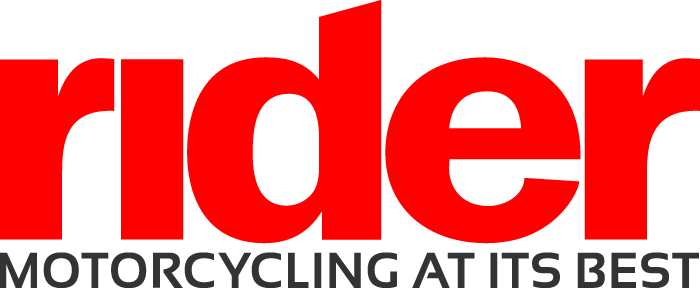
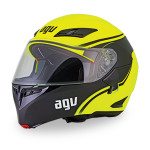
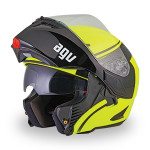
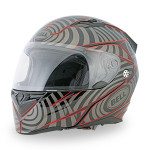
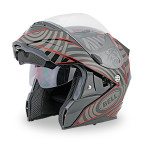
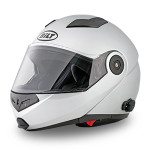
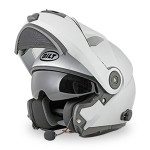
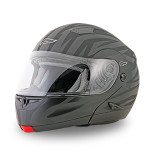
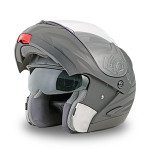
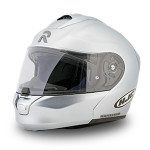
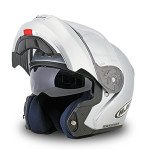
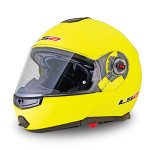
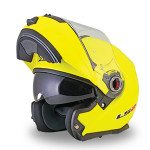
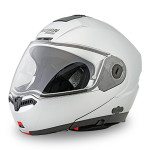
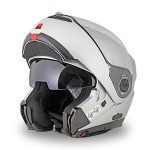
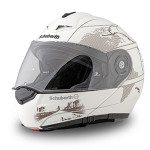
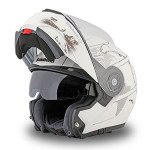
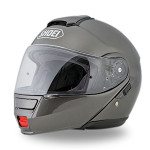
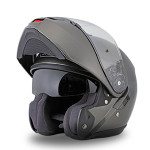
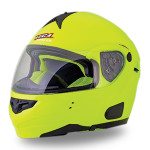
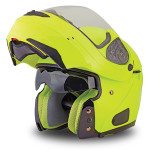
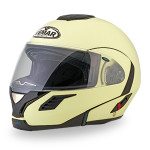
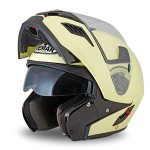


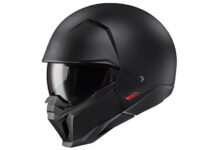




No decision made of which one you prefer and why???? Comon!! Could of done this online better with Revzilla ,Competition Accessories or any other online store. Really want to know about the Schuberth and Shoe Neotech!!!
Depends on what your looking for.They gave you the good and bad so you can make a decision.
Really be informative to know the size range, head circumference, these helmets came in. Why waste time looking for a helmet that don’t fit?
Why didn’t you test a Shark Evoline 3? It’s the only one certified by DOT or ECE with the chin bar in the raised or lowered position.
We have tested the Shark Evoline helmet in the past, it just didn’t make it into this particular buyers guide. http://ridermagazine.com/index.php?s=shark+evoline%22&x=0&y=0
That link is 6 years old . They are now on the Evo 3.
You dropped the ball not including it or the Roof as many people might not even be aware of their existance but would prefer a helmet that can be ridden open. I do.
By the way, thanks for the article.
A helmet in the Schuberth price range should come in more than 2 shell sizes. I have the Neotec and the HJC RPHA Max, and actually prefer the HJC. It’s the lightest of them all, it’s fairly quiet although I always ride with earplugs, it’s a lot cheaper, and a big one for me is that it doesn’t make you look like a bobble head doll, it just looks like a full face helmet.